Addiction Case Study: Assessment, Treatment Plan for Laura's Addiction
VerifiedAdded on 2020/05/28
|6
|1111
|455
Case Study
AI Summary
This assignment presents a detailed case study of a patient named Laura struggling with addiction. The student analyzes Laura's initial assessment, identifying her drug use (primarily alcohol and Xanax) and the potential impact on her mental and physical health. The case study explores concurrent disorders such as anxiety and depression, proposing cognitive behavioral therapy as a suitable treatment approach. The assignment covers the negative consequences of Laura's addiction, potential treatment approaches (abstinence and harm reduction), and how her case aligns with the DSM-V criteria for substance use disorder. Furthermore, it examines the application of the iceberg theory and the bio-psycho-social-spiritual model to Laura's situation, highlighting the need for further questions to understand her background. Finally, the assignment addresses the classification of substances Laura uses (depressants) and the application of motivational interviewing in her treatment plan.
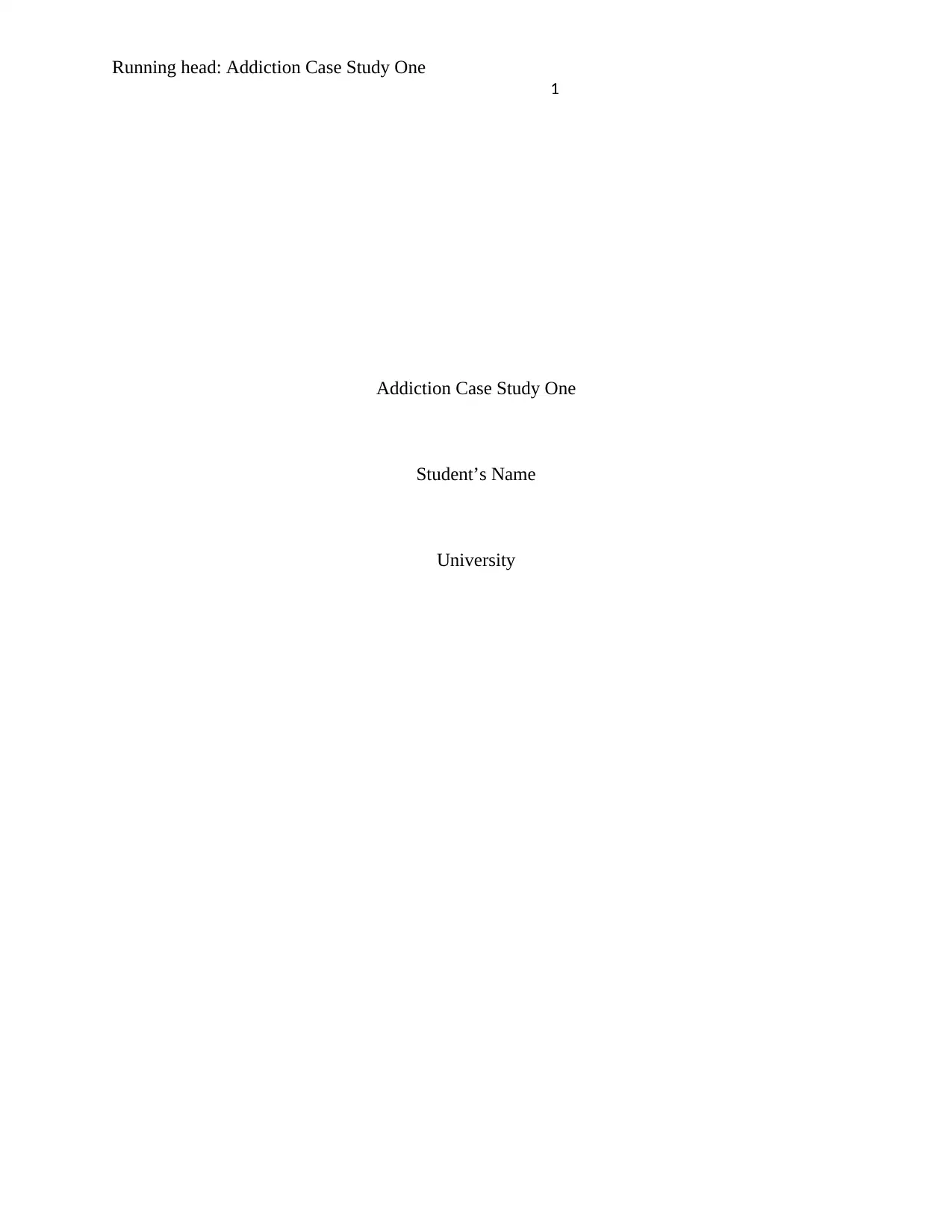
Running head: Addiction Case Study One
1
Addiction Case Study One
Student’s Name
University
1
Addiction Case Study One
Student’s Name
University
Paraphrase This Document
Need a fresh take? Get an instant paraphrase of this document with our AI Paraphraser
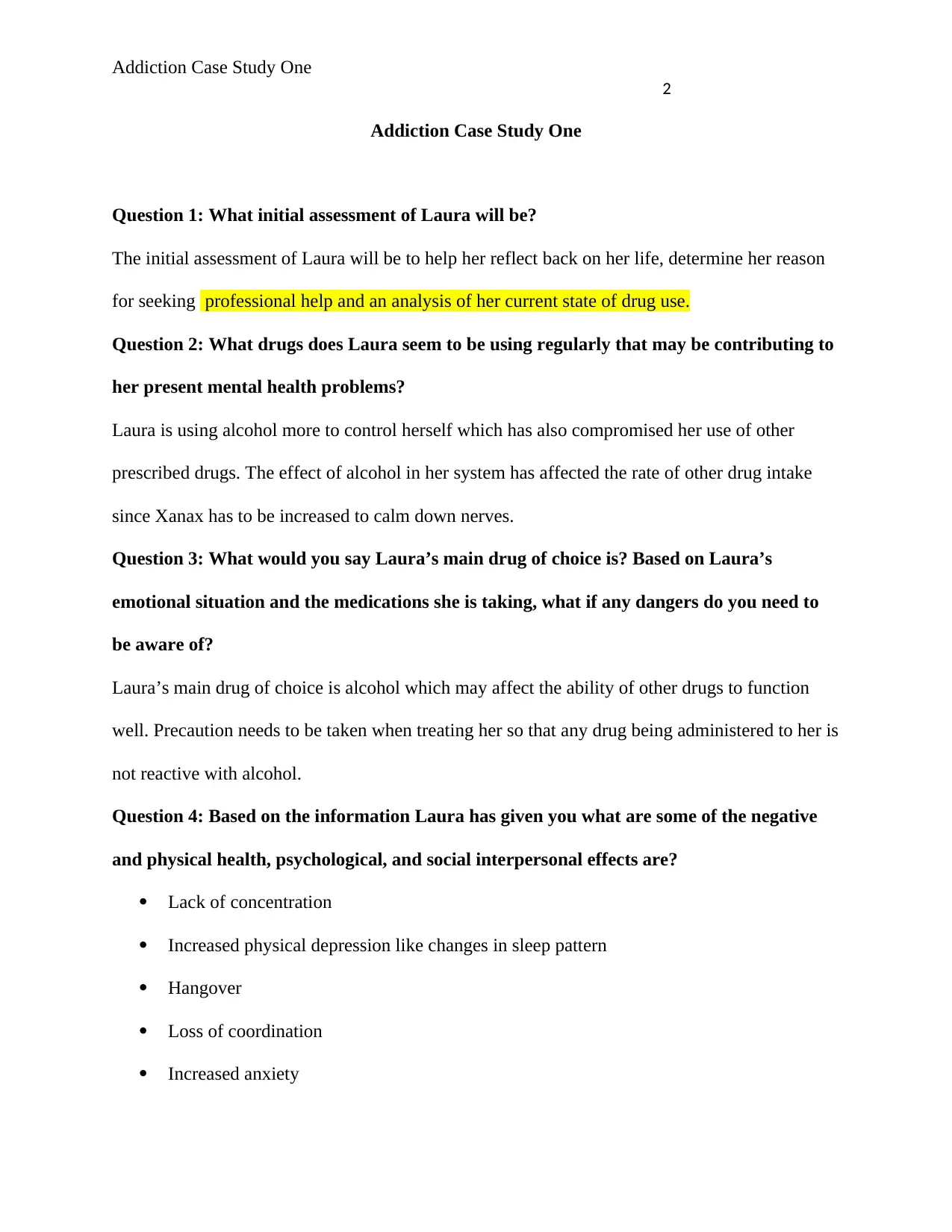
Addiction Case Study One
2
Addiction Case Study One
Question 1: What initial assessment of Laura will be?
The initial assessment of Laura will be to help her reflect back on her life, determine her reason
for seeking professional help and an analysis of her current state of drug use.
Question 2: What drugs does Laura seem to be using regularly that may be contributing to
her present mental health problems?
Laura is using alcohol more to control herself which has also compromised her use of other
prescribed drugs. The effect of alcohol in her system has affected the rate of other drug intake
since Xanax has to be increased to calm down nerves.
Question 3: What would you say Laura’s main drug of choice is? Based on Laura’s
emotional situation and the medications she is taking, what if any dangers do you need to
be aware of?
Laura’s main drug of choice is alcohol which may affect the ability of other drugs to function
well. Precaution needs to be taken when treating her so that any drug being administered to her is
not reactive with alcohol.
Question 4: Based on the information Laura has given you what are some of the negative
and physical health, psychological, and social interpersonal effects are?
Lack of concentration
Increased physical depression like changes in sleep pattern
Hangover
Loss of coordination
Increased anxiety
2
Addiction Case Study One
Question 1: What initial assessment of Laura will be?
The initial assessment of Laura will be to help her reflect back on her life, determine her reason
for seeking professional help and an analysis of her current state of drug use.
Question 2: What drugs does Laura seem to be using regularly that may be contributing to
her present mental health problems?
Laura is using alcohol more to control herself which has also compromised her use of other
prescribed drugs. The effect of alcohol in her system has affected the rate of other drug intake
since Xanax has to be increased to calm down nerves.
Question 3: What would you say Laura’s main drug of choice is? Based on Laura’s
emotional situation and the medications she is taking, what if any dangers do you need to
be aware of?
Laura’s main drug of choice is alcohol which may affect the ability of other drugs to function
well. Precaution needs to be taken when treating her so that any drug being administered to her is
not reactive with alcohol.
Question 4: Based on the information Laura has given you what are some of the negative
and physical health, psychological, and social interpersonal effects are?
Lack of concentration
Increased physical depression like changes in sleep pattern
Hangover
Loss of coordination
Increased anxiety
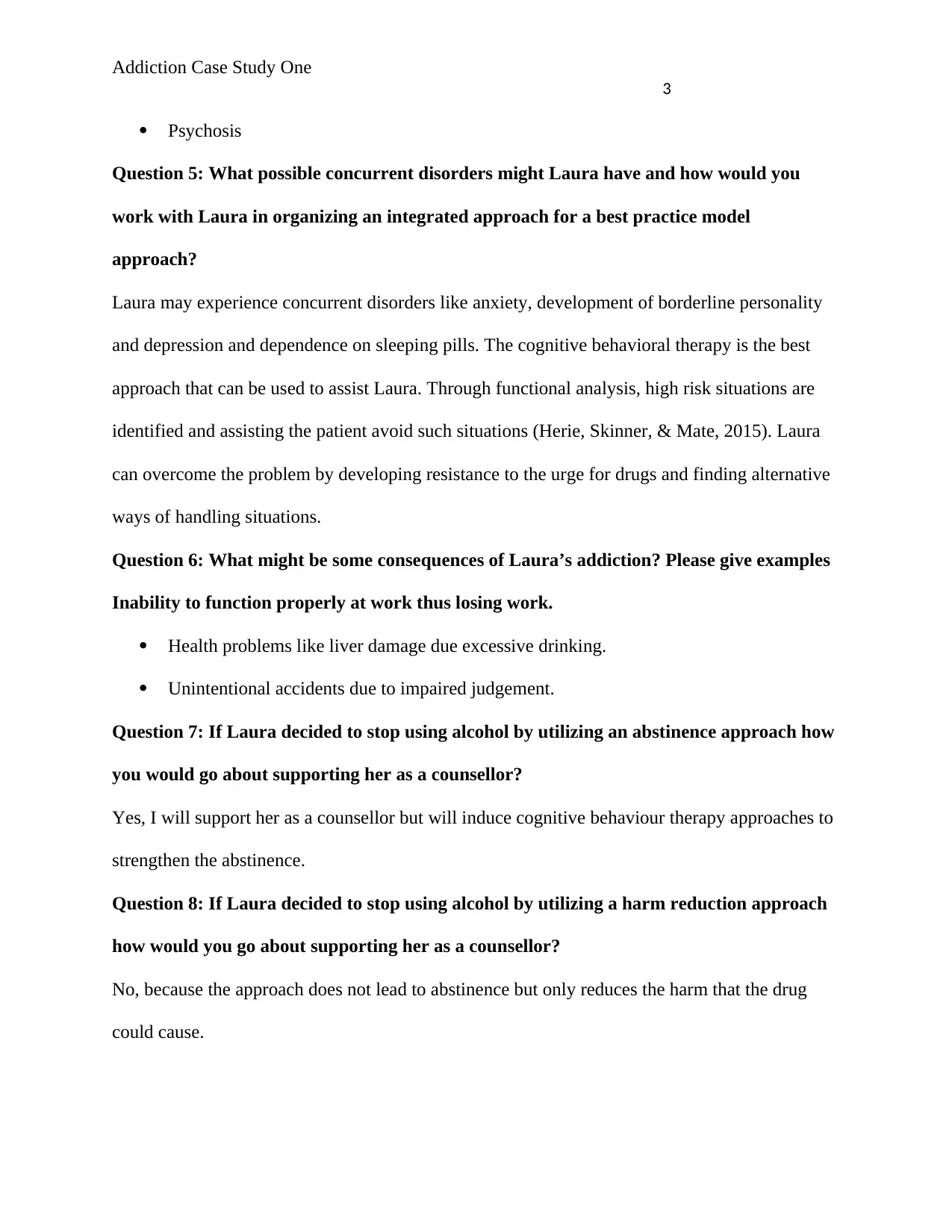
Addiction Case Study One
3
Psychosis
Question 5: What possible concurrent disorders might Laura have and how would you
work with Laura in organizing an integrated approach for a best practice model
approach?
Laura may experience concurrent disorders like anxiety, development of borderline personality
and depression and dependence on sleeping pills. The cognitive behavioral therapy is the best
approach that can be used to assist Laura. Through functional analysis, high risk situations are
identified and assisting the patient avoid such situations (Herie, Skinner, & Mate, 2015). Laura
can overcome the problem by developing resistance to the urge for drugs and finding alternative
ways of handling situations.
Question 6: What might be some consequences of Laura’s addiction? Please give examples
Inability to function properly at work thus losing work.
Health problems like liver damage due excessive drinking.
Unintentional accidents due to impaired judgement.
Question 7: If Laura decided to stop using alcohol by utilizing an abstinence approach how
you would go about supporting her as a counsellor?
Yes, I will support her as a counsellor but will induce cognitive behaviour therapy approaches to
strengthen the abstinence.
Question 8: If Laura decided to stop using alcohol by utilizing a harm reduction approach
how would you go about supporting her as a counsellor?
No, because the approach does not lead to abstinence but only reduces the harm that the drug
could cause.
3
Psychosis
Question 5: What possible concurrent disorders might Laura have and how would you
work with Laura in organizing an integrated approach for a best practice model
approach?
Laura may experience concurrent disorders like anxiety, development of borderline personality
and depression and dependence on sleeping pills. The cognitive behavioral therapy is the best
approach that can be used to assist Laura. Through functional analysis, high risk situations are
identified and assisting the patient avoid such situations (Herie, Skinner, & Mate, 2015). Laura
can overcome the problem by developing resistance to the urge for drugs and finding alternative
ways of handling situations.
Question 6: What might be some consequences of Laura’s addiction? Please give examples
Inability to function properly at work thus losing work.
Health problems like liver damage due excessive drinking.
Unintentional accidents due to impaired judgement.
Question 7: If Laura decided to stop using alcohol by utilizing an abstinence approach how
you would go about supporting her as a counsellor?
Yes, I will support her as a counsellor but will induce cognitive behaviour therapy approaches to
strengthen the abstinence.
Question 8: If Laura decided to stop using alcohol by utilizing a harm reduction approach
how would you go about supporting her as a counsellor?
No, because the approach does not lead to abstinence but only reduces the harm that the drug
could cause.
⊘ This is a preview!⊘
Do you want full access?
Subscribe today to unlock all pages.

Trusted by 1+ million students worldwide
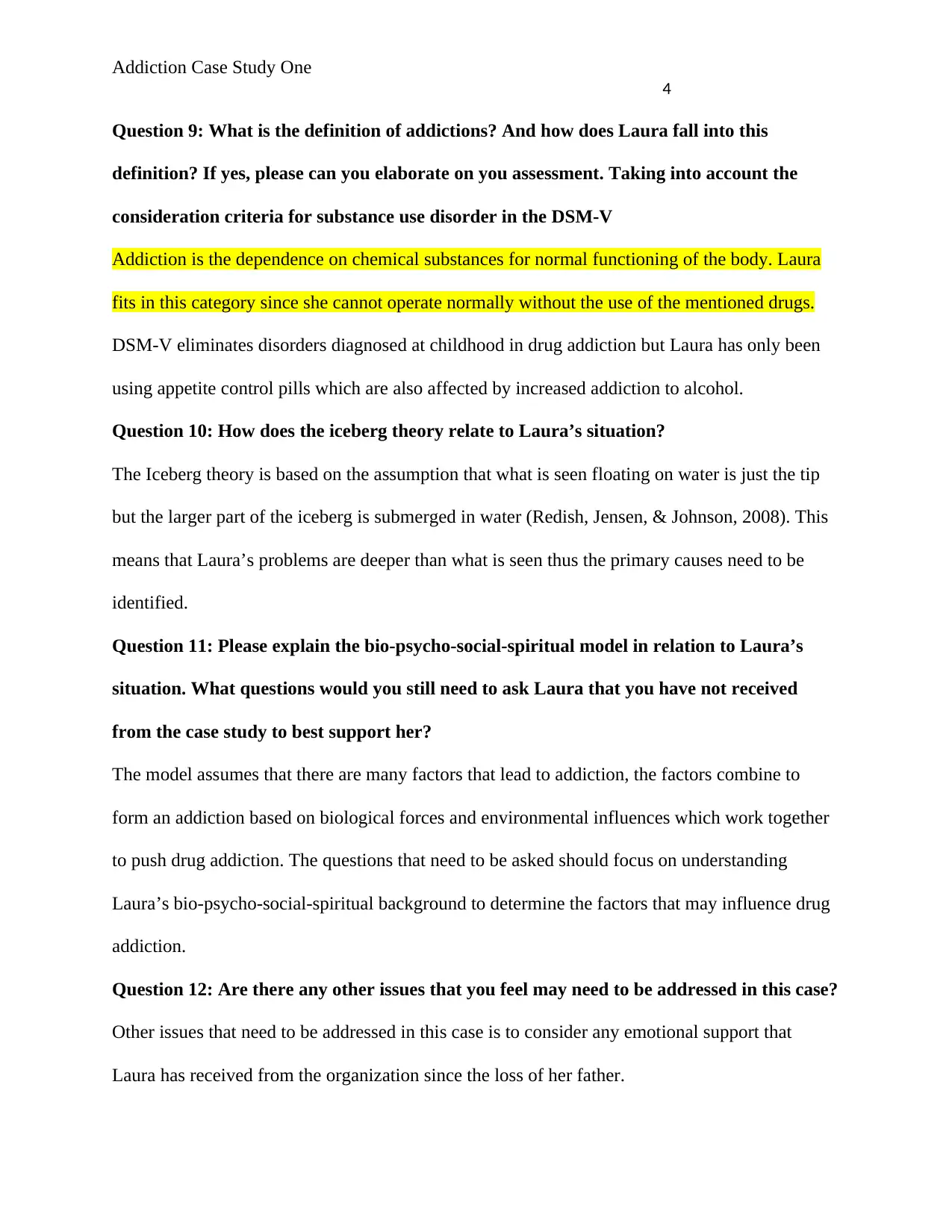
Addiction Case Study One
4
Question 9: What is the definition of addictions? And how does Laura fall into this
definition? If yes, please can you elaborate on you assessment. Taking into account the
consideration criteria for substance use disorder in the DSM-V
Addiction is the dependence on chemical substances for normal functioning of the body. Laura
fits in this category since she cannot operate normally without the use of the mentioned drugs.
DSM-V eliminates disorders diagnosed at childhood in drug addiction but Laura has only been
using appetite control pills which are also affected by increased addiction to alcohol.
Question 10: How does the iceberg theory relate to Laura’s situation?
The Iceberg theory is based on the assumption that what is seen floating on water is just the tip
but the larger part of the iceberg is submerged in water (Redish, Jensen, & Johnson, 2008). This
means that Laura’s problems are deeper than what is seen thus the primary causes need to be
identified.
Question 11: Please explain the bio-psycho-social-spiritual model in relation to Laura’s
situation. What questions would you still need to ask Laura that you have not received
from the case study to best support her?
The model assumes that there are many factors that lead to addiction, the factors combine to
form an addiction based on biological forces and environmental influences which work together
to push drug addiction. The questions that need to be asked should focus on understanding
Laura’s bio-psycho-social-spiritual background to determine the factors that may influence drug
addiction.
Question 12: Are there any other issues that you feel may need to be addressed in this case?
Other issues that need to be addressed in this case is to consider any emotional support that
Laura has received from the organization since the loss of her father.
4
Question 9: What is the definition of addictions? And how does Laura fall into this
definition? If yes, please can you elaborate on you assessment. Taking into account the
consideration criteria for substance use disorder in the DSM-V
Addiction is the dependence on chemical substances for normal functioning of the body. Laura
fits in this category since she cannot operate normally without the use of the mentioned drugs.
DSM-V eliminates disorders diagnosed at childhood in drug addiction but Laura has only been
using appetite control pills which are also affected by increased addiction to alcohol.
Question 10: How does the iceberg theory relate to Laura’s situation?
The Iceberg theory is based on the assumption that what is seen floating on water is just the tip
but the larger part of the iceberg is submerged in water (Redish, Jensen, & Johnson, 2008). This
means that Laura’s problems are deeper than what is seen thus the primary causes need to be
identified.
Question 11: Please explain the bio-psycho-social-spiritual model in relation to Laura’s
situation. What questions would you still need to ask Laura that you have not received
from the case study to best support her?
The model assumes that there are many factors that lead to addiction, the factors combine to
form an addiction based on biological forces and environmental influences which work together
to push drug addiction. The questions that need to be asked should focus on understanding
Laura’s bio-psycho-social-spiritual background to determine the factors that may influence drug
addiction.
Question 12: Are there any other issues that you feel may need to be addressed in this case?
Other issues that need to be addressed in this case is to consider any emotional support that
Laura has received from the organization since the loss of her father.
Paraphrase This Document
Need a fresh take? Get an instant paraphrase of this document with our AI Paraphraser
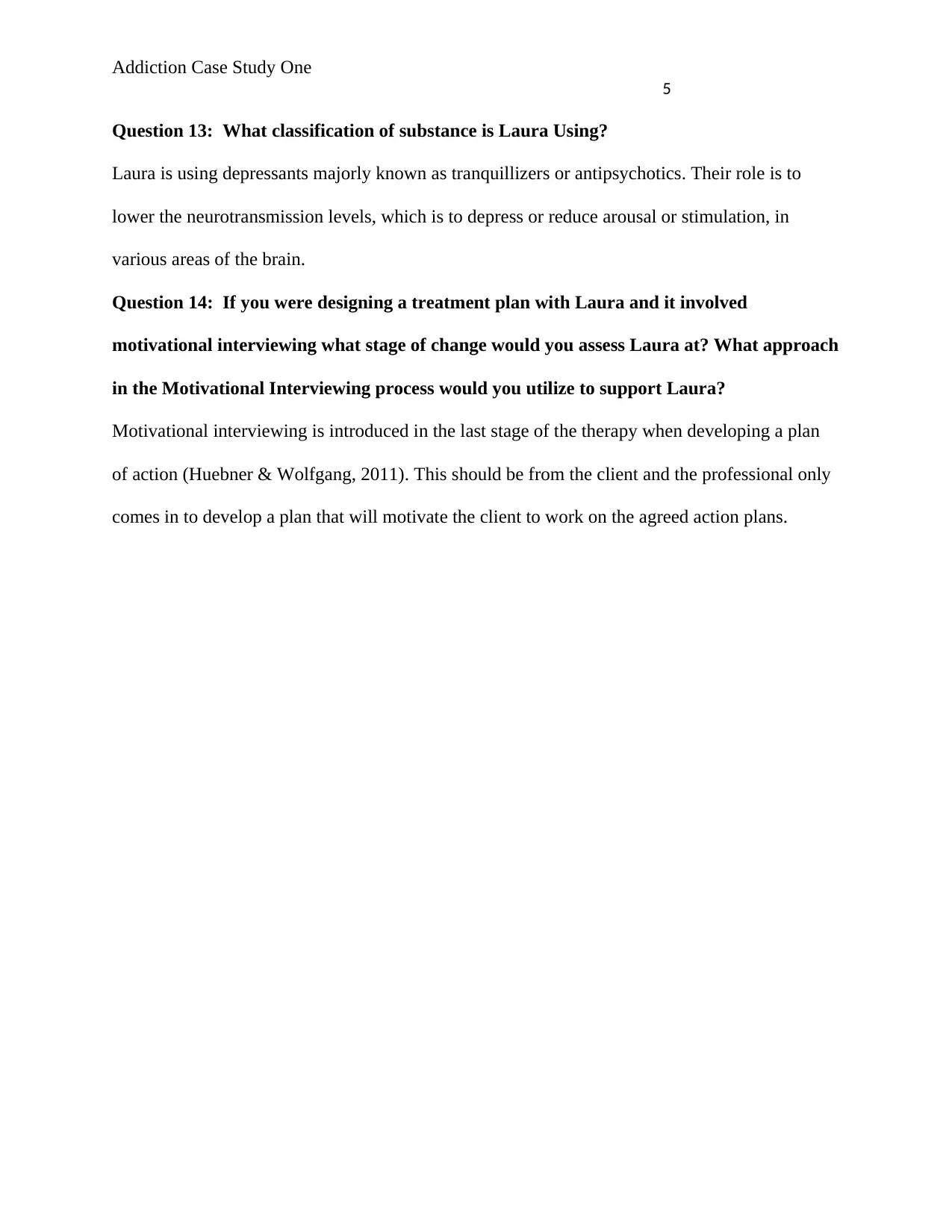
Addiction Case Study One
5
Question 13: What classification of substance is Laura Using?
Laura is using depressants majorly known as tranquillizers or antipsychotics. Their role is to
lower the neurotransmission levels, which is to depress or reduce arousal or stimulation, in
various areas of the brain.
Question 14: If you were designing a treatment plan with Laura and it involved
motivational interviewing what stage of change would you assess Laura at? What approach
in the Motivational Interviewing process would you utilize to support Laura?
Motivational interviewing is introduced in the last stage of the therapy when developing a plan
of action (Huebner & Wolfgang, 2011). This should be from the client and the professional only
comes in to develop a plan that will motivate the client to work on the agreed action plans.
5
Question 13: What classification of substance is Laura Using?
Laura is using depressants majorly known as tranquillizers or antipsychotics. Their role is to
lower the neurotransmission levels, which is to depress or reduce arousal or stimulation, in
various areas of the brain.
Question 14: If you were designing a treatment plan with Laura and it involved
motivational interviewing what stage of change would you assess Laura at? What approach
in the Motivational Interviewing process would you utilize to support Laura?
Motivational interviewing is introduced in the last stage of the therapy when developing a plan
of action (Huebner & Wolfgang, 2011). This should be from the client and the professional only
comes in to develop a plan that will motivate the client to work on the agreed action plans.
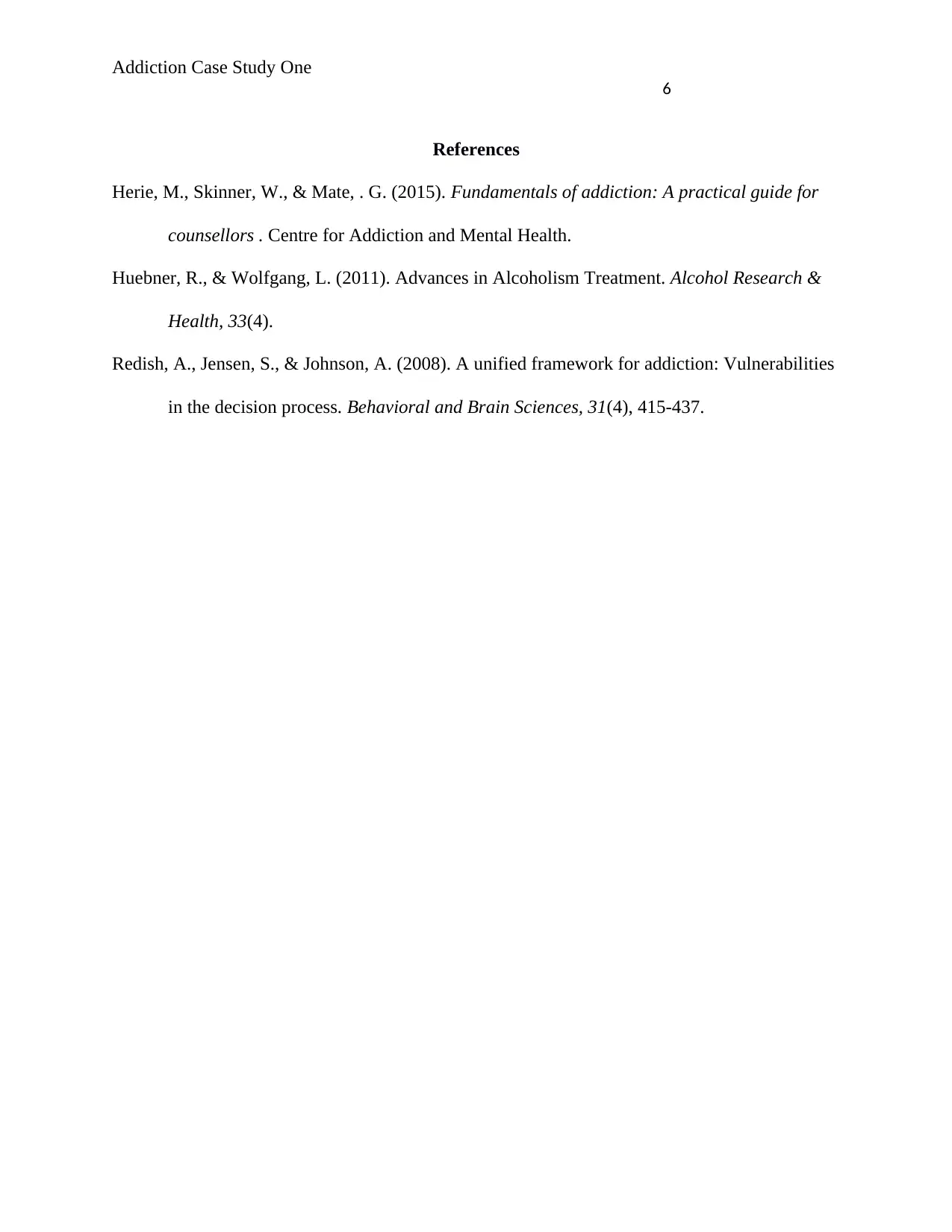
Addiction Case Study One
6
References
Herie, M., Skinner, W., & Mate, . G. (2015). Fundamentals of addiction: A practical guide for
counsellors . Centre for Addiction and Mental Health.
Huebner, R., & Wolfgang, L. (2011). Advances in Alcoholism Treatment. Alcohol Research &
Health, 33(4).
Redish, A., Jensen, S., & Johnson, A. (2008). A unified framework for addiction: Vulnerabilities
in the decision process. Behavioral and Brain Sciences, 31(4), 415-437.
6
References
Herie, M., Skinner, W., & Mate, . G. (2015). Fundamentals of addiction: A practical guide for
counsellors . Centre for Addiction and Mental Health.
Huebner, R., & Wolfgang, L. (2011). Advances in Alcoholism Treatment. Alcohol Research &
Health, 33(4).
Redish, A., Jensen, S., & Johnson, A. (2008). A unified framework for addiction: Vulnerabilities
in the decision process. Behavioral and Brain Sciences, 31(4), 415-437.
⊘ This is a preview!⊘
Do you want full access?
Subscribe today to unlock all pages.

Trusted by 1+ million students worldwide
1 out of 6
Related Documents
Your All-in-One AI-Powered Toolkit for Academic Success.
+13062052269
info@desklib.com
Available 24*7 on WhatsApp / Email
![[object Object]](/_next/static/media/star-bottom.7253800d.svg)
Unlock your academic potential
Copyright © 2020–2025 A2Z Services. All Rights Reserved. Developed and managed by ZUCOL.





